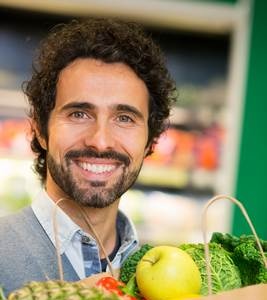|
 They said, "Go ahead, vegetarians!" They said: "Save the world!" But is a plant-based diet really as good for the environment as we are told? They said, "Go ahead, vegetarians!" They said: "Save the world!" But is a plant-based diet really as good for the environment as we are told?
People make the decision to go vegetarian for more than just the health benefits. For most, one of the main reasons to cut back on meat and dairy products is the impact on the environment. At least that's how it seems to everyone.
This year, about 150,000 people took part in Veganuary, a campaign in which participants live without animal products for a month. So to speak, they test the waters. Someone really tests themselves, while others contrive to disguise some of their goals under a healthy lifestyle.
Just take a look at social media. 220,000 Veganuary Instagram tags, endless tweets, featured articles such as “The 12 Best Vegan Instagrammers to Get Veguanuary Inspiration,” where the most important thing is how the food looks, not where it comes from, and what impact on the environment.
And they are not the only companions happily hopping onto the commercial cart; many companies saw banknotes in the concept of "vegetarianism". Tesco and Asda have launched a vegetarian food line, like. Old Walls is a dairy-free ice cream brand, and a horde of younger food brands - like the iconic Pip and Nut, or the Coconut Collaborative - are focusing on the fact that their products are dairy-free. Each supermarket has a section for vegetarians on its website. And this obsession with plant foods only grows over time.
The world is our gold mine
Over the past 10 years, the number of vegetarians has grown by 160%, but people should be asking "where this food comes from" when they throw fruits from all over the world into their baskets: pomegranate and mango from India, lentils from Canada, beans from Brazil, blueberries from the USA and Derezu from China. There are lamb chops from an in-town farm, and buying them is more environmentally friendly than eating an avocado from the other side of the world.
As we greedily plunder the world's grain supply, all the benefits go to the consumer - the source risks being left empty-handed. Take, for example, avocados and quinoa - their prices have skyrocketed due to high demand from foreign countries, and therefore residents of the supplying country cannot afford them at all.
Speaking of avocado
Kenya - the world's sixth largest supplier of this fruit - has banned the export of avocados because the country's own supply is at risk. The Department of Agriculture and Labor said the average price of a 90kg sack of avocado rose to KSh 2,560 (£ 18), the highest since May 2014. This affected, for the most part, the most popular varieties - Hass and Fuerte. This is due to the fact that over the past 5 years, exports have grown by 18% - up to 50,000 tons, according to the data of 2016.
 And they are not the only ones: Australia is also short of vegetables, which is why prices have to change dramatically. In Queensland, for example, prices have doubled over the year - up to $ 95A (USA54). The production of exported fruits in Mexico has been reduced, although the country remains the leader in sales of this fruit. And they are not the only ones: Australia is also short of vegetables, which is why prices have to change dramatically. In Queensland, for example, prices have doubled over the year - up to $ 95A (USA54). The production of exported fruits in Mexico has been reduced, although the country remains the leader in sales of this fruit.
Back in December, Mexico was thinking about importing avocados, which had been bringing a lot of profits to the state treasury for tens of thousands of years. Economy Minister Ildefonso Guayardo said that while Mexico now supplies about 45% of the world's avocado imports, this has not been reflected in their own consumption.This is because the price per kilogram is equal to the minimum daily wage of 80 pesos (£ 3). It is expected that this level will remain, which will have a negative impact on those who receive income. Mexico now makes more money selling seed fruit than oil, and this is the driving force behind illegal deforestation and replanting. avocado.
In 2013 - which the UN declared the year of quinoa - prices for the so-called Andean miracle cereal reportedly rose so much that locals can no longer afford it. But this cereal is one of the most important parts of the local diet. Since 2006, the price of this superfood has fluctuated, and now has reached $ 7 (? 5) per kilogram - more expensive than chicken - which led to a decline in the average consumption indicator. quinoa in 2014.
The current changes in the food industry show that we are well aware that we need to eat less meat and more vegetables, but with a reasonable balance.
Stay within the terrain
One solution to the problem is to seek local sources. Last year, many new restaurants opened with their own kitchen gardens. They grow their own seasonal vegetables and get rid of the carbon footprint that invariably comes from long-distance transportation. Seasonality - along with plant-based diets - were the two main trends of the past year.
Claire Smith, a three-star chef and owner of London's Core restaurant, truly believes in buying local produce. “As a chef, I feel a responsibility to support long-standing independent producers and try to do my part to protect the environment by using good quality local produce. My menu changes depending on the season and the availability of our suppliers. It is not very environmentally friendly to buy strawberries and asparagus from abroad in the winter when we have many other fruits and vegetables in the neighborhood. "
But eating food grown exclusively in the UK can be very difficult at times - especially in winter, during the so-called "hunger strike". Steven Lamb, meat quality expert at River Cottage, found her on a vegan diet this month. “I’m used to local and seasonal produce, but being a vegetarian in January is tough because it’s not there. I had to make do with watermelon and avocado, perhaps due to my lack of experience with vegetarian options at this time of year, ”he admits.
Home growing
Growing on the ground is not at all limited to food at a certain radius, because this would impose some limits. You can expand production throughout the country. According to the Vegan Society, the UK has good conditions for growing plant-based proteins that can be eaten raw: garden beans, peas, hemp and sweet lupine. However, now only 16% of the agricultural area is occupied by the cultivation of protein grains, and most of the harvest goes to the animals growing on the farm. At the same time, most of the proteins - such as lentils, mutton peas and quinoa (fit for human consumption) are imported from Brazil, Canada and the United States.
Grow Green's latest report, looking at future farming opportunities, states that these types of protein grains can contribute to food self-sufficiency and reduce the need for high-value imported foods. "Legumes do not need nitrogen or carbohydrate implantation: they are pollinated by insects and therefore enhance wildlife and biodiversity."
The move to grow more and more vegetables on your farm and rely less on other countries seems like a huge step forward, but it's not very difficult to make it.
In August, the first commercial harvest lentils in the UK was harvested from farms in England and sold at food festivals and the London Borough market.The Hodmedod's, who claim to be (rightfully) Britain's pioneer in grain, grow quinoa, lentils and garden beans in Essex. Prices start at? 1.79 for 500g.
Founders Josia Meldrum, Nick Saltmarsh and William Hudson were ahead of the planet, starting to think about it back in 2009. "We wanted to understand what an ecological diet should look like in a small town like Norwich," admits Meldrum. “We wanted to take a step towards eating less meat. And over the past five years, we've really seen people change their eating habits and the percentage of vegans has skyrocketed. "
But eating less meat isn't just good for the environment. This type of agriculture is also more beneficial to the land. “From a farming perspective, growing these cereals and increasing diversity shares risks and reduces plant diseases. If you plant millet year after year, you have to do a lot more to control the diseases that may develop in this cereal. So, in terms of the environment, growing more cereals is good for farmers, ”says Meldrum.
While the practice of sending food thousands of miles away will always be the case, Lamb says it is best to lessen the need for it by establishing "harmony between the wilderness of the countryside controlled by land and pasture and a place that would be left to grow cereals." "It needs to be done, and it needs to be managed so that activities like this are highly profitable and help produce more sustainable food."
Do it yourself
But you cannot rely on a company to hope that it will do all the hard work. Simple changes can be made at home, from growing your own plants to ordering a vegetable box, which also helps eliminate plastic and waste.
Riverford Organic Farm, located in South Devon, says a British Veggie Box is enough to reduce the environmental impact of vegetarianism. “Vegetables are always tastier when they are fresh and when in season — especially when grown in organic soil,” says Emily Madderman. The boxes are assembled from different products up to 8 weeks old. It uses the finest seasonal vegetables and does not airborne, helping to reduce food waste.
Jack Monroe, Chef and Veganuary Ambassador, says you hardly need a lot of space to grow anything on your own - from hanging baskets of strawberries to salads that can be grown in baking tins on windowsills. “Wilko sells plant pots that cleverly attach to standard water pipes to create a living wall of herbs and spices. The gutter can water the plants for you. ”
“Mangold is a medium-sized plant and is almost impossible to kill. I had the same plant for two years, and I easily harvested 50 crops before moving to a new home. All you need is a bucket of soil and some sunlight. It can be picked when young and cut into salads, or grown to gigantic proportions like spring vegetables, ”says Monroe.
Where is the balance?
While it is important to avoid food that has traveled thousands of miles, it is also important not to boycott exported food, as their production provides abundance for many developing countries.
According to Meldrum, quinoa use is on the rise, so we need to remember where it comes from. “We would recommend purchasing from small cooperative farms and producers who are able to report income,” he says.
It is in our power to choose the best food to reduce the negative impact on the environment.
Gastin A.
|
 They said, "Go ahead, vegetarians!" They said: "Save the world!" But is a plant-based diet really as good for the environment as we are told?
They said, "Go ahead, vegetarians!" They said: "Save the world!" But is a plant-based diet really as good for the environment as we are told?





